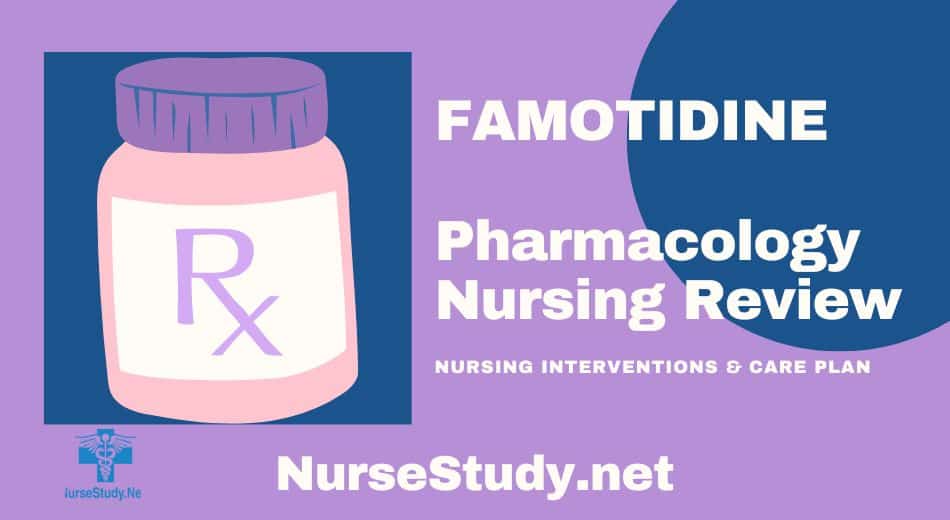Famotidine is a histamine-2 (H2) receptor antagonist, commonly known as Pepcid. It reduces stomach acid production and is used to treat various gastrointestinal conditions. This medication is available both as a prescription and over-the-counter drug.
Generic names: Famotidine
Brand names: Pepcid, Pepcid AC, Pepcid Complete, Fluxid, Heartburn Relief
Pharmacologic class: Histamine-2 receptor antagonist
Therapeutic class: Antiulcer agent, gastric acid secretion inhibitor
Mechanism of action: Famotidine works by competitively inhibiting histamine at H2 receptors in gastric parietal cells, which reduces gastric acid secretion, gastric volume, and hydrogen concentrations.
Indications for use: Treatment and prevention of duodenal ulcers, gastric ulcers, gastroesophageal reflux disease (GERD), erosive esophagitis, Zollinger-Ellison syndrome, and heartburn. It is also used for stress ulcer prophylaxis in critically ill patients.
Precautions and contraindications: Hypersensitivity to famotidine or other H2 antagonists. Use with caution in patients with renal impairment, elderly patients, and pregnant or breastfeeding women. Dosage adjustment is required in patients with moderate to severe kidney dysfunction.
Drug Interactions
- Antacids may decrease the absorption of famotidine
- May decrease absorption of drugs requiring acidic pH (ketoconazole, itraconazole)
- Sucralfate should be administered 2 hours after famotidine
- It may increase blood levels of triazolam and midazolam
Adverse Effects
- Headache and dizziness
- Constipation or diarrhea
- Nausea and vomiting
- Dry mouth
- Muscle cramps
- Fatigue and weakness
- Rare: confusion, hallucinations (especially in the elderly)
- Rare: blood disorders, liver dysfunction
- Rare: skin reactions including Stevens-Johnson syndrome
Administration Considerations
Available preparations: Tablets (20mg, 40mg), oral suspension, and IV solution
Dosages:
- Regular-release tablets: 20mg once or twice daily
- Maximum dose: 40mg twice daily
- IV: 20mg every 12 hours
- Dosage reduction required in renal impairment
Routes and Timing:
- Oral: Can be taken with or without food
- IV: Administered over at least 2 minutes
- For GERD: Best taken 15-60 minutes before meals
Nursing Considerations for Famotidine
Related Nursing Diagnoses
- Risk for imbalanced nutrition related to altered gastric acid production
- Acute pain related to gastrointestinal disorder
- Risk for fluid volume deficit related to gastrointestinal symptoms
- Deficient knowledge related to medication regimen
- Risk for impaired comfort related to GERD symptoms
Nursing Assessment
Assess for allergies to famotidine or other H2 blockers
Evaluate baseline gastrointestinal symptoms including:
- Heartburn frequency and severity
- Presence of black, tarry stools
- Abdominal pain characteristics
- Nausea and vomiting
Assess renal function through BUN and creatinine levels
Monitor for signs of gastrointestinal bleeding
Assess the mental status of elderly patients
Nursing Interventions
Administer medication as prescribed, ensuring proper timing in relation to meals
Monitor the effectiveness of therapy through symptom relief
For IV administration:
- Dilute according to the manufacturer’s guidelines
- Administer over the recommended time
- Monitor injection site
Monitor for adverse effects, especially in elderly patients
Assess for drug interactions with other medications
Patient Teaching Associated with Famotidine
Explain the purpose of the medication and expected outcomes
Instruct on proper timing of medication:
- For GERD prevention: Take 15-60 minutes before meals
- Can be taken with or without food
- Space doses evenly throughout the day
Discuss common side effects and when to report to a healthcare provider:
- Severe headache
- Unusual fatigue
- Mental changes
- Skin rashes
- Black, tarry stools
Teach lifestyle modifications:
- Avoid trigger foods
- Eat smaller meals
- Avoid lying down for 2-3 hours after meals
- Elevate the head of the bed
Emphasize the importance of:
- Not exceeding the recommended dose
- Completing the full course of therapy
- Regular follow-up appointments
- Reporting persistent symptoms
Guide OTC use:
- Maximum duration of self-treatment
- When to seek medical attention
- Importance of reading labels for proper dosing
Note: This is not an all-inclusive list of possible drug interactions, adverse effects, precautions, nursing considerations, or patient instructions. Please consult with a pharmacist for complete information.
References and Sources
- Ackley, B. J., Ladwig, G. B., Makic, M. B., Martinez-Kratz, M. R., & Zanotti, M. (2023). Nursing diagnoses handbook: An evidence-based guide to planning care. St. Louis, MO: Elsevier.
- Bc, J. B. D. A., Rosenthal, L., & Yeager, J. J. (2021). Study Guide for Lehne’s Pharmacology for Nursing Care. Saunders.
- Harding, M. M., Kwong, J., & Hagler, D. (2022). Lewis’s Medical-Surgical Nursing: Assessment and Management of Clinical Problems, Single Volume. Elsevier.
- Herdman, T. H., Kamitsuru, S., & Lopes, C. (2024). NANDA International Nursing Diagnoses – Definitions and Classification, 2024-2026.
- Ignatavicius, D. D., Rebar, C., & Heimgartner, N. M. (2023). Medical-Surgical Nursing: Concepts for Clinical Judgment and Collaborative Care. Elsevier.
- Mejia A, Kraft WK. Acid peptic diseases: pharmacological approach to treatment. Expert Rev Clin Pharmacol. 2009 May;2(3):295-314. doi: 10.1586/ecp.09.8. PMID: 21822447; PMCID: PMC3149864.
- New therapeutic options in the treatment of GERD and other acid-peptic disorders. Based on a presentation by Duane D. Webb, MD, FACG. Am J Manag Care. 2000 May;6(9 Suppl):S467-75. PMID: 10977486.
- Nguyen K, Dersnah GD, Patel P, et al. Famotidine. [Updated 2024 Jan 14]. In: StatPearls [Internet]. Treasure Island (FL): StatPearls Publishing; 2024 Jan-. Available from: https://www.ncbi.nlm.nih.gov/books/NBK534778/
- Silvestri, L. A. (2023). Saunders comprehensive review for the NCLEX-RN examination. St. Louis, MO: Elsevier.
